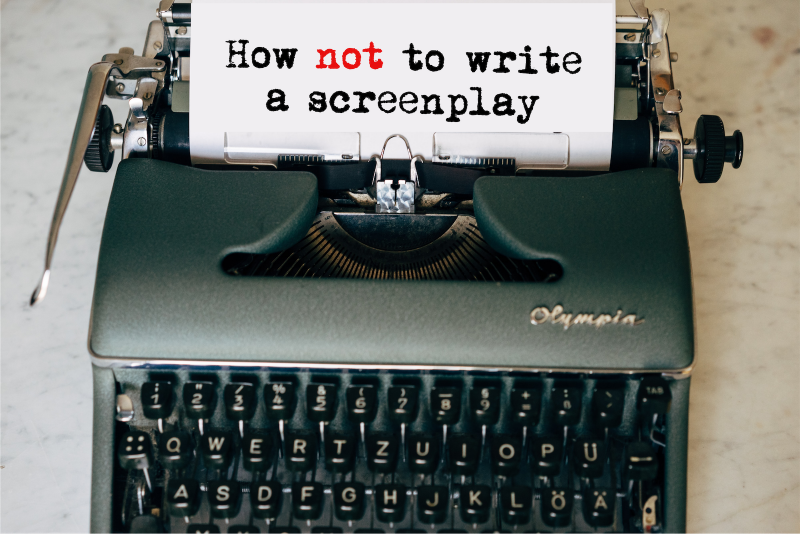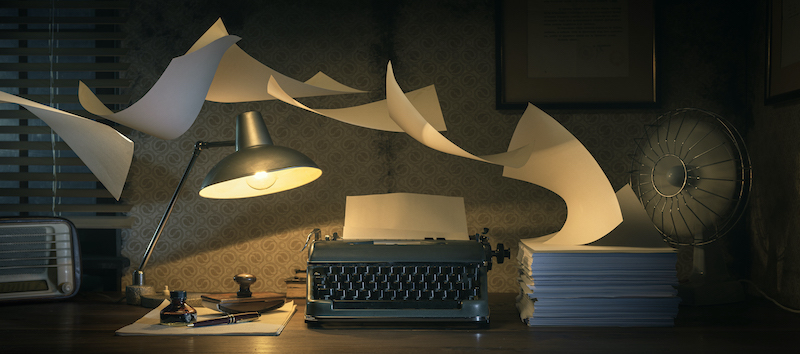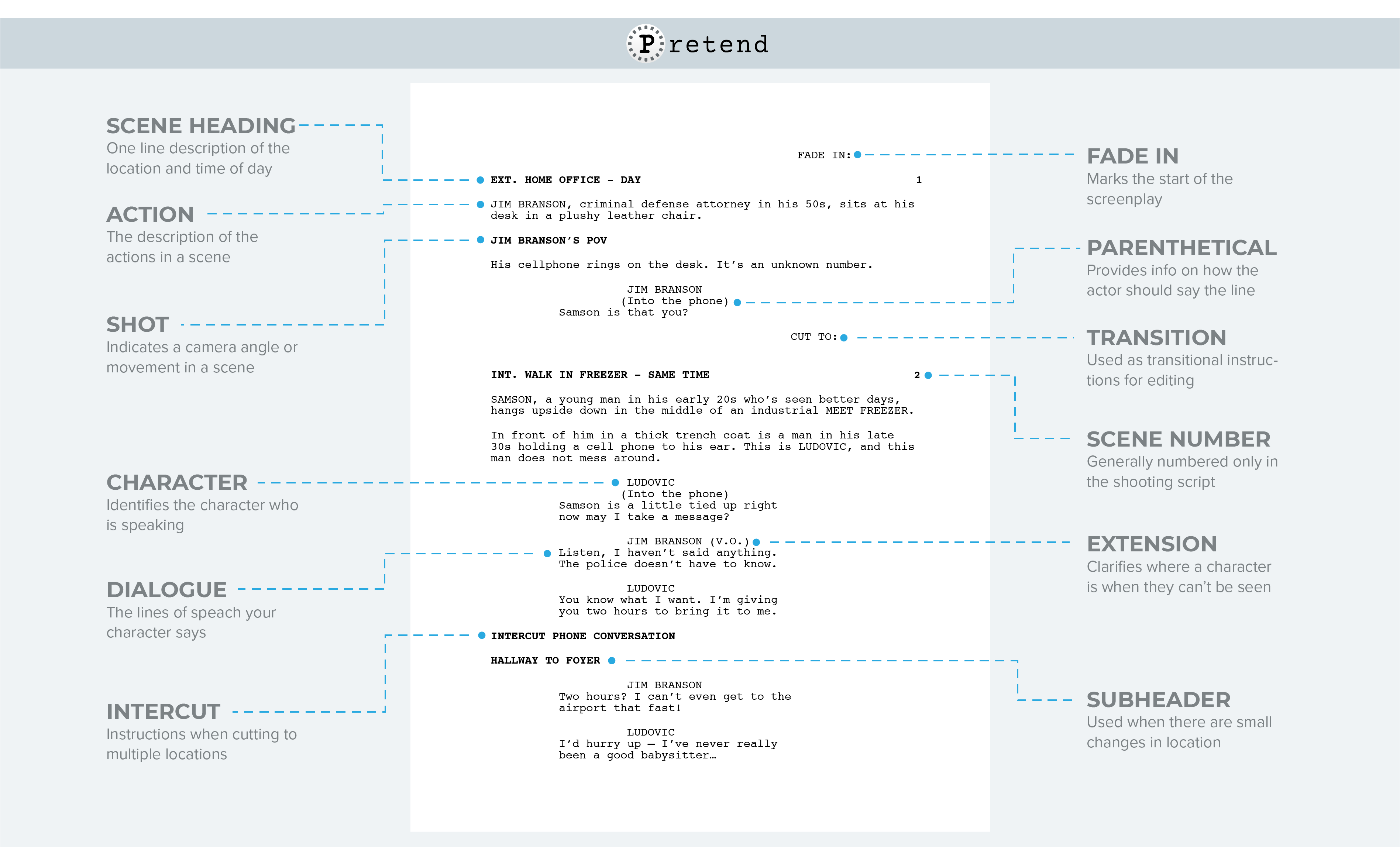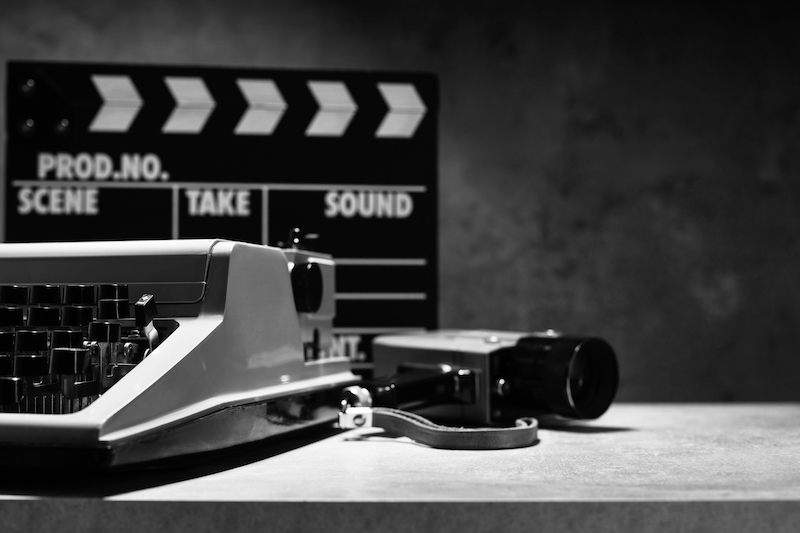
How Not to Write a Screenplay
So, you’ve finally decided to write that story that’s been tickling the back of your brain? Great! Now what? Should you go straight to writing a well-formatted screenplay with scene headings and dialogue? Absolutely not, especially if this is one of your first screenwriting endeavors.
A script has a very specific format, which can be a deterrent for any aspiring filmmaker. There’s so much you can do before writing your first scene heading in order to prepare yourself for the best script-writing experience. Notice how I said "best" and not "good" or "amazing"—screenwriting is a process that’s bound to be emotionally enduring at times (at best). If you find yourself crying in front of a blank page or screen, hang in there, you’re probably on the right track.
Before we dive in, I’d like to preface by saying that even though some professionals might find tips in this article, I wrote this with novice screenwriters trying to get their first script off the ground in mind! Let’s dig in...

Preparing Your Story
Before doing any research or trying to structure all of your plot points, you need to think about your story—the one you want to tell and why.
Although you might have a grasp on some of the elements you want to include in your film, you need to think of the reason for which you want to tell this story—this will help immensely in the development of your narrative as you’ll have identified the main objective.
Are you trying to ask a question? If so, you’ll want your audience to encounter that same question in your story at some point. Make sure to not literally ask that question in the film, as audiences are natural problem-solvers and will want to identify the question on their own. Or perhaps you’re trying to shed light on an unknown issue? In that case, you could start from the perspective of a character that is also in the dark about this subject.
Whether you’re trying to find purpose within your film’s intent or trying to give your characters’ life and reason, there are some great references out there to help you get started. A great book every beginner should read is The Writer’s Journey by Christopher Vogler, which allows you to question and analyze who your characters are and how they should develop. Another great pillar of storytelling is Save the Cat by Blake Snyder, which dives into the greater purpose of your story’s narrative and how it should be shaped to fit your objective. Keep in mind that although these must-read guidelines have somewhat of a commercial and general approach to storytelling, I recommend learning the rules before trying to break them!
The point is that it’s during this crucial moment, before the writing begins, that you get to question both the journey of the characters in your story and the response your audience will have to this story. Once you decide what your film’s intention is, and why you chose to make it, you’ll see each character and plot point as driving forces, bringing your audience towards your objective.
This is where you get a chance to differentiate yourself from the masses. Because among all the thousands of films that get released each year, the ones that stick with you (and win awards) are the ones that have thought put into their story and objective.

Can You Keep a Secret?
I’m not sure how often this next tip is given out to fellow writers, but it’s something that I swear by today—beware of instant gratification.
Allow me to explain... When you set yourself up for something—like writing a story or even going on a diet—you’re overwhelmed with excitement and pride. Good gosh, you think, I’m doing something productive and worthwhile with my time! It feels good, and sometimes you’ll want to share that excitement with your friend, lover, or even the poor checkout clerk who’s just trying to get on with his day. Don’t.
Even though hearing an attaboy might feel gratifying, what’s really happening is that you are cashing in a check that has not yet been written. You’re asking for the reward before having found the dog. You are jumping on a small bit of gratification when it’s so much more exciting and productive to keep it to yourself, at least for a while.
This is something you might have already experienced, but you can get a lot more writing done if you just keep your story secret. Of course, you can discuss your film with people who might help with the development of your story or project. Just make sure to question what you’re really after when discussing your project. You’ll want to finish writing your story, and when you finally do share it with the world, it will be a thousand times more rewarding.
Write It or Forget It
Let me know if this sounds familiar. You’ve just decided to sit down and start writing your masterpiece, when all of a sudden, you realize that those jaw-dropping ideas you had last night don’t feel so fresh anymore. You can’t even remember that opening scene that made you want to write this story in the first place! Damn it.
Don’t worry – this happens. For that reason, I’d like to introduce one of the most technologically efficient inventions of humankind—the notepad. Whether it’s in the shape of a journal, the notes app on your phone, voice recordings, or just a good ol’ scratchpad, writing down your notes as soon as they enter your mind will give you an instant sense of relief (nothing gets forgotten) along with a great personalized source of material for your project.

Due Diligence of Research
Another great source of inspiration stems from the due diligence of research. Eureka! It’s what separates all the well-thought-out stories from the mediocre ones — and I’m not talking about just filling your story up with hard facts!
Research comes in many forms, and although you might be writing about someone you know from head to toe, you’ll find out that there’s a lot more to research than just finding facts that relate to your story. Watching films with a similar tone asyour story, talking to people who know and understand your subject, and watching documentaries and interviews are one of many examples of the different forms of research you can undergo.
Some of you may interpret this as me saying that all stories must be based on the truth, which is completely false! Research is to be used as a stepping stone in your journey. Often, I’ll be reading or watching something and an idea for a scene or a piece of dialogue will drop-kick me to the floor, right out of the blue! That’s when I run to my notes and write my idea down for safekeeping. I’ll leave you with this: research is not about fact-finding, it’s about finding inspiration for your story, however it may come.

Outlines Are Here to Help!
The time has come to take all of those notes and scribbles and start shaping them into a story. I’m not saying that you haven’t written multiple scenes at this point—this often happens during the research process since we’re flushed with inspiration — simply, it’s time to organize your thoughts into a constructed narrative. After all, that’s what a story is!
You’ll want to start with a script outline. This is what most industry professionals will want to read before investing their precious time into reading your full-length script. Most outlines are about 3-5 pages long (for feature films) and are essentially a scene-by-scene breakdown of your film.
Consider an outline as the framing of a house, or as the skeleton in your body (any invertebrates reading this?)—essentially this is the blueprint for your script. The outline contains all the important moments in your story, also called "beats,", which are the building blocks of any plot structure and can be defined as an event, realization, resolution, or interaction. You can find examples of beat sheets for all of your favorite films on the Save the Cat website, along with plenty of other resources to help you get started.
In terms of formatting your outline, you’ll want to include separate paragraphs, each describing individual scenes in the present tense (Neo takes the blue pill), along with any important snippets of dialogue that are important to your story’s theme or narrative.
Outlines are a great way to foresee problems that may occur during the screenwriting process. They allow you to make sure that all of your scenes make sense and that your characters are undergoing their much-deserved development throughout your story.
Once you have an outline, you can always go back to it and add more details and dialogue until you feel like you’ve included all the beats of your story, which will set you up for the best screenwriting experience.
Writing in Script Form
Now that you have your story, it’s time to write your first draft. Finally!
Hopefully, at this point, you’ve nailed down all the beats or major plot points of your story, you know what your characters are after and how they will develop throughout the film, and you’ve got some ideas for some pieces of dialogue. If you’re still unhappy with some of the events in your story, don’t sweat it. A big part of writing is re-writing, and we’ll discuss that next.
Assuming you’ve done the work, you now have an outline with at least one small paragraph per scene. Note that some people write outlines that are several dozens of pages long because they just keep adding onto them until they’ve written so much that they just have to transfer them into script form, and that’s fine too. Either way, you’re ready to write your script.
There’s plenty of great free screenwriting software out there, including our very own Pretend, which helps automate the process by formatting headings, actions, and dialogue while you write! You’ll even be able to add notes and use our editing platform to help storyboard your project for a potential pitch.
Regardless of the software you’re using, you’ll be using your outline as a tool to develop your scenes into script form. Although I’m sure you know what a script looks like, let’s go over the five elements that make up a scene.
1/ Scene Headings
INT. BROOKLYN APARTMENT – DAY
Scene headings are what all scenes start with. They’re meant to introduce the place and time of day during which the scene occurs. It’s important to note that all scene headings are written in ALL CAPS!
The options for the first part are:
INT. is an abbreviation for "interior" and signifies that the scene will occur indoors.
EXT. is an abbreviation for "exterior." The scene is happening outside.
In some rare instances, you can also use the following:
INT./EXT. means the scene starts inside and ends outside (someone running out of their house to chase the mailman).
EXT./INT. You guessed it—this means the scene starts outside and ends indoors.
What follows is a description of the location. Notice that in the example above, we used BROOKLYN APARTMENT, but some writers will use multiple hyphens to describe a more specific part of their setting.
INT. BROOKLYN APARTMENT – BATHROOM – DAY
This will save you some time from having to describe the exact location within your action lines. Speaking of...
2/ Action Lines
Action lines in your script serve the purpose of describing any visual or audible actions that you can see or hear on-screen. They must always be written in the third person in the present tense (Luke grabs his light saber).
It’s in your action lines that you can also use ALL CAPS to introduce new props or other important audio-visual actions that have an important place in your story.
Example:
James Bond runs away from the building when an EXPLOSION sends him flying into the shoreline.
3/ Dialogue
Dialogue is always written beneath the name of the character saying it. Just like you and me, a character can say any combination of words under the stars. A good rule of thumb is to stay away from anything boring or redundant.
Within your dialogue, you have a couple of tools available to help show where the dialogue is coming from on-screen and how it’s said.
// Extensions
Extensions are written next to the character's name and help show where the voice is coming from. They’re always written in between parentheticals.
(V.O.) means Voice Over, and shows that the dialogue is being narrated over the images on screen. Think of a nature documentary!
(O.S.) means Off Screen, aand helps to show that the line of dialogue is being spoken by a character that is not currently on screen—perhaps someone is shouting from another room, or from inside a closet.
// Parentheticals
Parentheticals specify how or to whom something is said! You can use them to show that someone is yelling or whispering, and you can also use them to help us visualize who your character is talking to when in a room full of other characters.
Use them when needed, but a script with too many parentheticals can seem a bit heavy and leaves less room for a reader to use their own imagination when reading your story.
4/ Fonts and Margins
You’ll want to write your script using a 12 point Courier font and 1" margins, but you don’t have to worry about that since Pretend will do it for you automatically.
Reads and Re-Writes
Congratulations! You’ve written a script. That’s something to be proud of. It’s now time to turn this solid script into your very own masterpiece. How? through reading and re-writing.
Some writers will tell you that you need to re-write your script at least 3-5 times. Others will tell you that a script is never finished, there’s only a point where you’ll stop working on it. The former sounds a little more encouraging.
Just like any work of art, the artist decides when it’s done.
I’ll point out that, where some screenwriting apps only allow you to write one script before having to pay, Pretend allows you to write as many as you’d like for FREE. Now that you have a handle on how to write your script, get out there and write as many as you’d like. Break a leg!

Resources
Screenplay Format Example

Luckily, there are easy ways to convert your screenplays.




